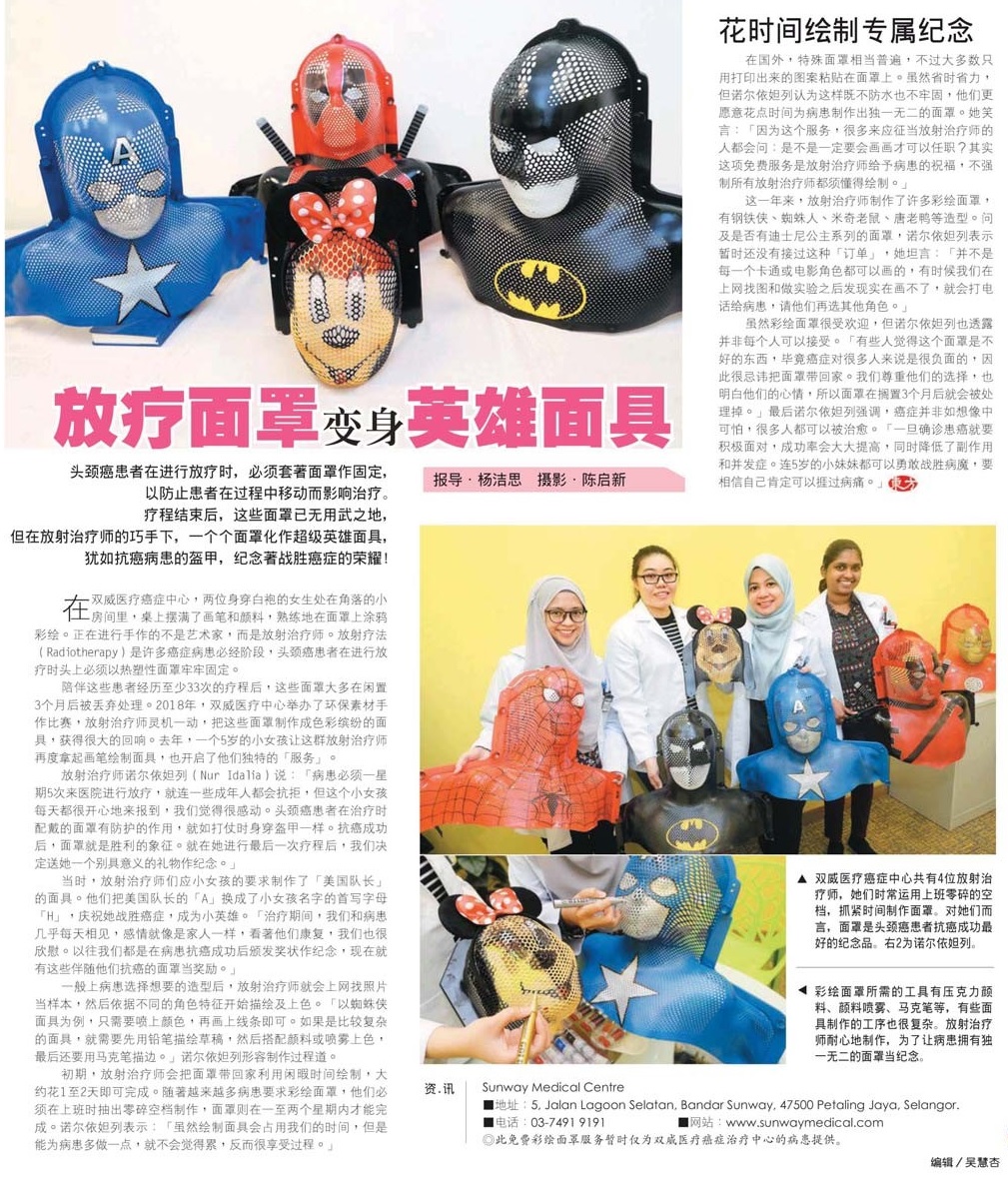Radiotherapy masks transformed into hero masks
17 March 2020

Radiotherapy is mandatory for many cancer patients and for patients with head and neck cancer, they are required to have a thermoplastic mask securely attached to their head while undergoing radiotherapy. The mask prevents them from moving during the procedure and affecting the treatment. At the end of the treatment, these masks are no longer useful and after being through at least 33 radiotherapy sessions with a patient, the mask is disposed after three months.
Today, these masks are being transformed not by artists, but radiotherapists who skilfully paint them into superhero masks – signifying the patient’s armour while fighting cancer and later, a trophy for defeating cancer.
The idea to transform the masks came to them in 2018 when a handicraft contest using environmental-friendly materials was organised. The masks received an overwhelming response during the contest and last year, the radiotherapists were given the chance to pick up their paintbrushes again for a 5-year-old patient, creating their own unique “service”.
“Patients have to come to the hospital five times a week for their radiotherapy sessions, that even some adults would resist the treatment. We were touched at how happy this little girl would come in for treatment every day,” said Nur Idalia, a radiotherapist at Sunway Medical Centre.
“The mask worn by head and neck cancer patients during treatment has a protective effect, like wearing an armour during battle. The mask is also a symbol of victory after their successful fight against cancer. When she had her last radiotherapy session, we decided to gift the mask her to keep as a special memory,” she said.
The radiotherapists had designed a “Captain America” mask upon the request of the little girl. But instead of the letter “A” for Captain America, they replaced it with the letter “H” for the little girl’s name, celebrating her victory over cancer and becoming a little hero.
“We meet our patients almost every day for their treatment. They are like our family and it is comforting to see them recover. We used to give out certificates to patients after they have successfully fought cancer. Now, we have these masks that have accompanied them in their journey,” Nur Idalia said.
When a patient has chosen his or her desired design, the radiotherapists will search online looking for templates of the design, and then begin to paint according to the characteristics of the character.
“For the Spider-Man mask, we sprayed the colour first before drawing the lines. For more complex designs, a draft is sketched with a pencil before it is coloured with paint or spray, and then edged with a marker,” shared Nur Idalia about the process.
The radiotherapists often took the masks home to paint it during their free time, which took about one to two days to complete. With more and more patients requesting the painted masks, they now utilise their gaps at work to paint, which can be completed in one to two weeks.
“Although designing the masks takes up our time, we don’t feel tired. We enjoy the process as we are doing it for the patients,” Nur Idalia said.
Specially designed masks are fairly common abroad where most of the designs are printed out and pasted onto the mask. Although it saves time and effort, Nur Idalia feels that the method is neither waterproof nor sturdy, therefore they prefer to take the time to create the unique masks for their patients.
“Because of this service, many who apply for the job as a radiotherapist ask if drawing skills is a must to get the job. In fact, this is a complimentary service from the radiotherapists to the patient and it is not mandatory that all radiotherapists must know how to draw,” she said.
The radiotherapists have made many painted masks over the past year including Iron Man, Spider-Man, Mickey Mouse and Donald Duck. They have yet to receive any requests for Disney Princesses, said Nur Idalia.
“Not every cartoon, animation or movie character can be drawn. We often look for designs on the internet and try to draw out. When we find that it is impossible to draw, we will call the patient and ask them to choose another character,” she said.
Despite the popularity of the painted masks, Nur Idalia revealed that they are not for everyone. “Some people think the mask is a bad thing. After all, cancer has a negative connotation so it is taboo to bring the mask home. We respect their choice and understand how they feel, therefore the mask will be disposed after three months,” she said.
Nur Idalia stressed that cancer is not as scary as one might think and it is a fact that many have been cured. “Confronting it positively will have a much higher success rate with fewer side effects and complications. Even a 5-year-old girl can defeat it bravely! Have faith that you can also get through it,” she said.
Source: Oriental Daily News
Back


